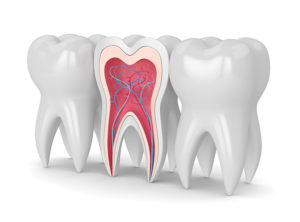
Hearing “root canal” during a dental exam and consultation might seem overwhelming for some patients. But the truth is that dental technology has come a long way in recent years, making it more convenient than ever the treat an infected tooth. In fact, a root canal treatment can be as comfortable as a general filling.
FAQ about Root Canals
If you need a root canal, then it is normal to have questions about the procedure. Our team is here to help you find the right answers, giving you peace of mind in knowing that you are receiving quality services. Here are some of the most common questions asked by our patients:
Q: Why is the root canal needed?
A: When the inside of the tooth becomes infected, it is necessary to remove the pulp contained within the inner part of the tooth. Infection and inflammation in the middle of the tooth can occur because of decay that spread throughout the tooth, a crack or chip, or multiple dental procedures on that tooth. If the infection is left untreated, then it often results in pain and can lead to the formation of an abscess.
Q: Is it painful to have a root canal?
A: The root canal treatment is no more uncomfortable than having a normal filling. This treatment helps to relieve the intense pain experienced when the tooth is infected. The local area will be numbed during the treatment, giving you a pain-free experience while the work is done.
Q: Is a root canal better than tooth extraction?
A: An infected tooth can lead to other dental complications, which is why immediate treatment is essential. One alternative to a root canal is to extract the infected tooth. But we encourage patients to save the natural teeth whenever possible. While tooth replacement is available with bridges and implants, nothing is as good as your natural tooth. A root canal treatment allows you to keep your original tooth and avoid extraction. Additionally, a root canal is cheaper compared to the cost of extraction followed by an implant or bridge to replace the tooth.
Q: Does a root canal weaken my tooth?
Removing the inner section of the tooth weakens the overall structure of the tooth. But it can be reinforced with dental restorations, such as an onlay or dental crown. We will provide the right treatment to ensure the strength of your tooth after the root canal is complete.
Q: What should I expect after a root canal treatment?
When the numbing wears off, you won’t have the same, severe pain that was present before the root canal. The inner nerves have been removed, giving you relief. Most people find that the area is tender for a few days while the surrounding tissues are healing. It can be helpful to eat soft foods and take over-the-counter pain medication during the recovery time.
If you have additional questions about root canals (or other dental services), then you are invited to contact our team any time for assistance. myDental is here to help! Schedule an appointment at one of our convenient locations.